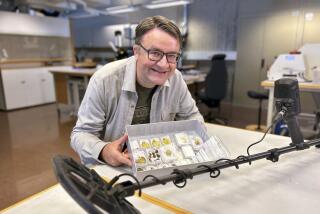Artifacts hint at early jade trade
- Share via
Jade pendants and earrings from archaeological sites throughout the southwestern Pacific originated in Taiwan, suggesting the existence of a sophisticated regional trade network much earlier than previously believed.
The itinerant craftspeople who transported the jade and transformed it into jewelry probably carried their language with them as well, spreading the Austronesian languages throughout the region, Australian researchers reported Monday in the Proceedings of the National Academy of Sciences.
Archaeologist Hsiao-Chun Hung of the Australian National University and her colleagues studied 144 three-pointed jade earrings, called lingling-os, and two-headed animal pendants from the Philippines, Malaysia, Vietnam and Thailand.
Using an electron probe microanalyzer to determine the relative amounts of iron, magnesium and silicon in the jade, they concluded that 116 of the artifacts were from a well-known jade mine at Fengtian on the eastern coast of Taiwan. The artifacts dated from 3,000 BC to AD 500.
Only one jade artifact, a lingling-o, has been found on Taiwan itself. But researchers have found castoff pieces of jade throughout the region, indicating that jade “blanks” were shipped from Taiwan and crafted locally.
The manufacture of jewelry required not only a high level of skill, but also a great deal of patience and labor, because of the crude tools that were available. Hung noted that eight hours of sawing on jade with a stone knife and sand will cut a groove only 11 millimeters, or less than half an inch, deep. An hour of drilling with bamboo, sand and water produces a hole only 10 millimeters deep.
So far, no researcher has found iron tools associated with jade manufacturing.
The team is now trying to pinpoint the origin of the other samples, Hung said.
--






